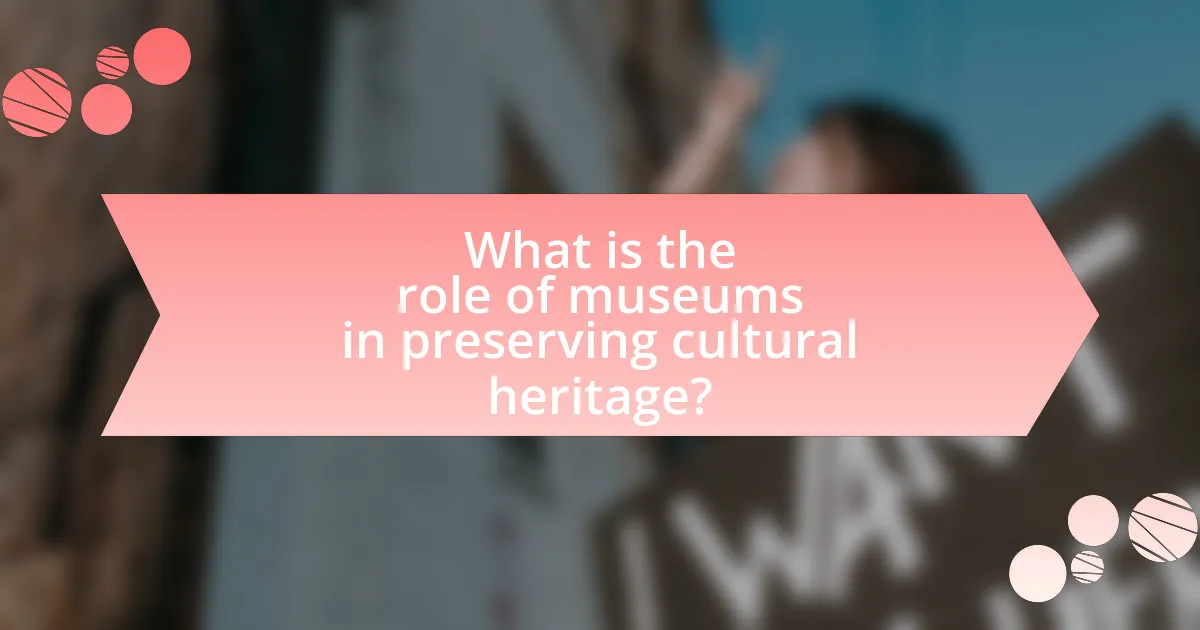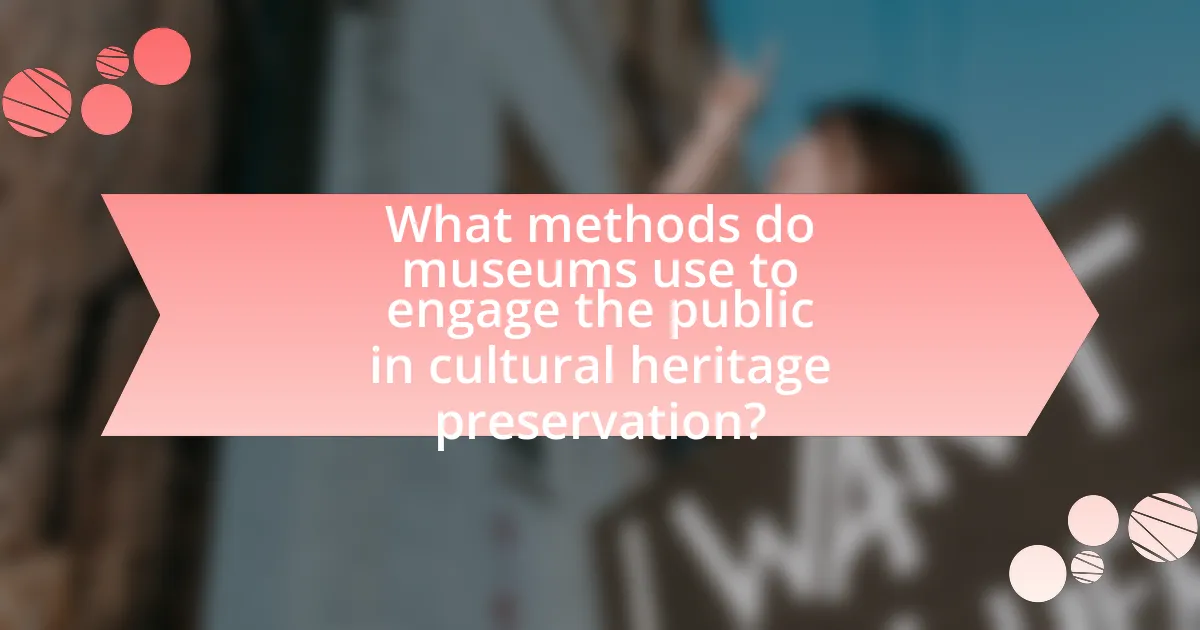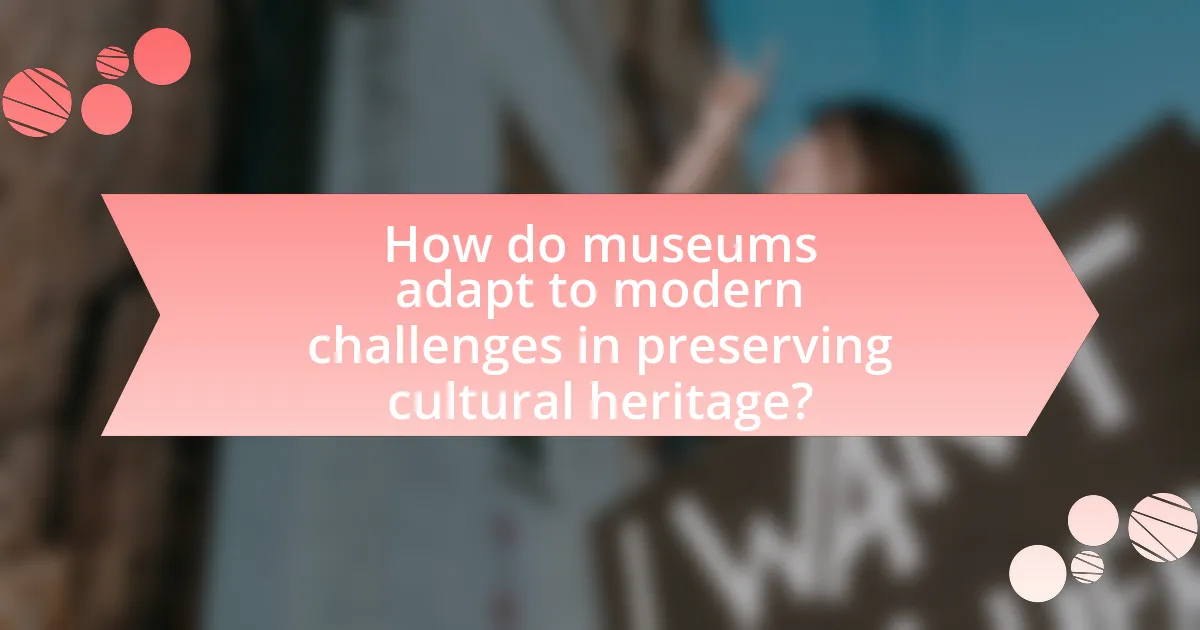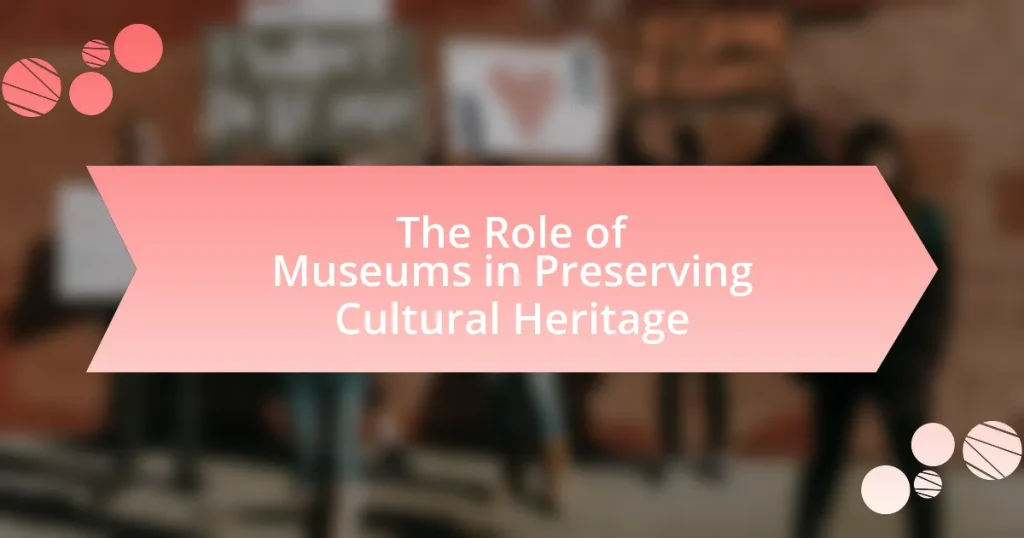Museums serve as vital institutions in the preservation of cultural heritage, collecting, conserving, and exhibiting artifacts that reflect the diverse histories and identities of various cultures. They employ specialized conservation techniques and maintain controlled environments to protect cultural artifacts, ensuring their longevity for future generations. The article explores the types of artifacts preserved by museums, the importance of cultural heritage to society, and the methods museums use to engage the public in preservation efforts. Additionally, it addresses the challenges museums face today, including funding limitations and climate change, while highlighting best practices for effective cultural heritage preservation.

What is the role of museums in preserving cultural heritage?
Museums play a crucial role in preserving cultural heritage by collecting, conserving, and exhibiting artifacts that represent the history and identity of various cultures. They safeguard tangible and intangible heritage, ensuring that future generations can access and learn from these cultural resources. For instance, the International Council of Museums (ICOM) emphasizes that museums contribute to cultural preservation by maintaining collections that reflect diverse histories and narratives, thus fostering understanding and appreciation of cultural diversity. Additionally, museums often engage in research and educational programs that promote awareness of cultural heritage, further solidifying their role as custodians of cultural identity.
How do museums contribute to the preservation of cultural artifacts?
Museums contribute to the preservation of cultural artifacts by employing specialized conservation techniques and maintaining controlled environments for display and storage. These institutions utilize trained conservators who assess the condition of artifacts, implement restoration processes, and apply preventive measures to mitigate deterioration. For instance, the Smithsonian Institution has established rigorous standards for temperature and humidity control, which are critical in preserving delicate items like textiles and paper artifacts. Additionally, museums often engage in research and documentation, creating detailed records that enhance understanding and facilitate future conservation efforts. This systematic approach ensures that cultural artifacts are safeguarded for future generations, thereby fulfilling the museums’ role as stewards of cultural heritage.
What types of cultural artifacts do museums typically preserve?
Museums typically preserve a variety of cultural artifacts, including historical objects, artworks, textiles, manuscripts, and archaeological finds. These artifacts serve to represent and document the cultural heritage of societies, providing insights into their history, beliefs, and practices. For instance, the British Museum houses the Rosetta Stone, which is crucial for understanding ancient Egyptian writing, while the Louvre preserves the Mona Lisa, a significant work of art that reflects Renaissance culture. Such artifacts are essential for education, research, and the promotion of cultural understanding.
How do museums ensure the proper conservation of these artifacts?
Museums ensure the proper conservation of artifacts through controlled environmental conditions, regular monitoring, and specialized conservation techniques. They maintain specific temperature and humidity levels to prevent deterioration, often utilizing climate control systems. Additionally, museums conduct routine inspections and assessments to identify any signs of damage or degradation. Conservation professionals employ methods such as cleaning, repairing, and stabilizing artifacts, ensuring that they remain in optimal condition for future generations. For example, the American Institute for Conservation recommends best practices that include using archival materials and techniques to protect artifacts from light exposure and physical wear.
Why is cultural heritage important to society?
Cultural heritage is important to society because it fosters a sense of identity and belonging among individuals and communities. This shared heritage provides a framework for understanding history, traditions, and values, which are essential for social cohesion. For instance, UNESCO recognizes that cultural heritage contributes to sustainable development by promoting cultural diversity and fostering mutual respect among different communities. Additionally, cultural heritage can enhance economic growth through tourism, as seen in cities like Rome and Kyoto, where historical sites attract millions of visitors annually, generating significant revenue. Thus, cultural heritage plays a crucial role in shaping societal values, promoting economic benefits, and preserving collective memory.
How does cultural heritage influence community identity?
Cultural heritage significantly influences community identity by providing a shared sense of history, values, and traditions that bind individuals together. This shared heritage fosters a collective identity, as seen in communities that celebrate local festivals, maintain traditional crafts, or preserve historical sites. For example, the preservation of indigenous languages and practices has been shown to strengthen community ties and enhance social cohesion, as evidenced by studies conducted by the United Nations Educational, Scientific and Cultural Organization (UNESCO) which highlight the role of cultural heritage in promoting social identity and community resilience.
What are the consequences of losing cultural heritage?
Losing cultural heritage results in the erosion of identity and community cohesion. When cultural heritage is lost, individuals and communities may experience a disconnection from their historical narratives, leading to diminished social bonds and a weakened sense of belonging. For instance, UNESCO reports that the destruction of cultural sites can lead to the loss of traditional knowledge and practices, which are vital for cultural continuity. Additionally, the economic impact can be significant, as cultural heritage often drives tourism and local economies; the World Bank estimates that cultural tourism can account for up to 40% of total tourism revenue in some regions. Thus, the consequences of losing cultural heritage extend beyond individual identity to affect social structures and economic stability.

What methods do museums use to engage the public in cultural heritage preservation?
Museums engage the public in cultural heritage preservation through educational programs, interactive exhibits, community outreach, and digital initiatives. Educational programs, such as workshops and lectures, inform visitors about the significance of cultural heritage and encourage active participation in preservation efforts. Interactive exhibits allow visitors to experience heritage firsthand, fostering a deeper connection and understanding. Community outreach initiatives, including partnerships with local organizations, promote awareness and involvement in preservation activities. Digital initiatives, such as virtual tours and online resources, expand access to cultural heritage, enabling broader public engagement. These methods collectively enhance public awareness and participation in preserving cultural heritage.
How do educational programs in museums promote cultural awareness?
Educational programs in museums promote cultural awareness by providing interactive and informative experiences that highlight diverse cultures and histories. These programs often include workshops, guided tours, and lectures that engage visitors with artifacts and narratives from various cultural backgrounds, fostering understanding and appreciation. For instance, the Smithsonian Institution offers educational initiatives that explore Native American history, allowing participants to learn directly from cultural representatives and experts. This direct engagement with cultural content enhances visitors’ knowledge and empathy, ultimately contributing to a broader societal understanding of cultural diversity and heritage.
What types of educational programs are most effective?
Interactive and experiential educational programs are the most effective types of educational programs. These programs engage participants through hands-on activities, fostering deeper understanding and retention of knowledge. Research indicates that experiential learning, such as that found in museum settings, enhances cognitive and emotional connections to the material, leading to improved learning outcomes. For example, a study by the American Alliance of Museums found that visitors who participated in interactive exhibits demonstrated a 30% increase in knowledge retention compared to those who engaged with traditional, passive displays.
How do museums collaborate with schools and communities?
Museums collaborate with schools and communities through educational programs, workshops, and outreach initiatives that enhance learning and cultural engagement. These collaborations often include guided tours, interactive exhibits, and curriculum-based resources designed to align with educational standards. For instance, the Smithsonian Institution partners with local schools to provide access to artifacts and educational materials, fostering a deeper understanding of cultural heritage. Additionally, community events hosted by museums, such as cultural festivals or art classes, encourage local participation and strengthen community ties, demonstrating the museum’s role as a vital educational and cultural resource.
What role do exhibitions play in cultural heritage preservation?
Exhibitions play a crucial role in cultural heritage preservation by providing a platform for the display and interpretation of artifacts, traditions, and narratives that embody a community’s history and identity. They facilitate public engagement and education, allowing visitors to connect with their cultural heritage and understand its significance. For instance, the International Council of Museums (ICOM) emphasizes that exhibitions not only showcase cultural artifacts but also promote awareness and appreciation of diverse heritages, thereby fostering respect and understanding among different cultures. This engagement is vital for the ongoing preservation efforts, as it encourages support for conservation initiatives and the safeguarding of cultural practices.
How do temporary and permanent exhibitions differ in their impact?
Temporary and permanent exhibitions differ significantly in their impact on audiences and cultural engagement. Temporary exhibitions often create a sense of urgency and excitement, attracting visitors with new and unique content that may not be available again, thereby increasing foot traffic and engagement during their limited run. For instance, a study by the American Alliance of Museums found that temporary exhibitions can boost attendance by up to 30% compared to permanent collections. In contrast, permanent exhibitions provide a stable and ongoing opportunity for education and reflection, allowing visitors to develop a deeper understanding of cultural heritage over time. This sustained exposure fosters long-term relationships with the museum and its collections, as evidenced by visitor surveys indicating that repeat visitors often cite permanent exhibitions as a key reason for their return. Thus, while temporary exhibitions drive immediate interest and attendance, permanent exhibitions cultivate lasting connections and educational value.
What strategies do museums use to curate exhibitions that highlight cultural heritage?
Museums employ several strategies to curate exhibitions that highlight cultural heritage, including thematic storytelling, community engagement, and collaboration with cultural experts. Thematic storytelling allows museums to create narratives that connect artifacts to broader cultural contexts, enhancing visitor understanding and appreciation. Community engagement involves involving local communities in the curation process, ensuring that exhibitions reflect authentic cultural perspectives and practices. Collaboration with cultural experts, such as historians and anthropologists, ensures that the information presented is accurate and respectful of the cultures represented. These strategies collectively foster a deeper connection between visitors and cultural heritage, promoting awareness and preservation.

How do museums adapt to modern challenges in preserving cultural heritage?
Museums adapt to modern challenges in preserving cultural heritage by implementing advanced technologies, enhancing community engagement, and developing sustainable practices. For instance, many museums now utilize digital archiving and 3D scanning to create virtual collections, making cultural artifacts accessible to a global audience while reducing physical handling. Additionally, museums are increasingly collaborating with local communities to ensure that cultural narratives are accurately represented and preserved, as seen in initiatives like community-curated exhibitions. Furthermore, sustainable practices, such as energy-efficient building designs and environmentally friendly conservation methods, are being adopted to address climate change impacts on heritage sites. These strategies demonstrate museums’ proactive approach to overcoming contemporary challenges in cultural heritage preservation.
What technological advancements are being utilized in museums?
Technological advancements utilized in museums include virtual reality (VR), augmented reality (AR), interactive displays, and digital archiving systems. These technologies enhance visitor engagement and provide immersive experiences that allow users to explore exhibits in innovative ways. For instance, VR enables users to experience historical events or environments, while AR overlays digital information onto physical artifacts, enriching the educational experience. Additionally, interactive displays facilitate hands-on learning, and digital archiving systems preserve artifacts and documents in a format that ensures long-term accessibility and protection. These advancements are supported by studies showing increased visitor satisfaction and educational outcomes when technology is integrated into museum experiences.
How does digital archiving benefit cultural heritage preservation?
Digital archiving significantly benefits cultural heritage preservation by ensuring the long-term accessibility and protection of cultural artifacts and documents. This method allows for the creation of high-quality digital representations of physical items, which can be stored securely and accessed remotely, thus reducing the risk of loss or damage due to environmental factors or human error. For instance, the British Library has digitized millions of items, making them available to a global audience, which enhances public engagement and educational opportunities. Furthermore, digital archiving facilitates the preservation of fragile materials that may deteriorate over time, ensuring that future generations can study and appreciate their cultural heritage.
What role does social media play in promoting cultural heritage awareness?
Social media plays a crucial role in promoting cultural heritage awareness by providing a platform for sharing information, engaging communities, and facilitating discussions about cultural practices and artifacts. Through visual storytelling, museums and cultural organizations can showcase their collections and heritage initiatives, reaching a global audience. For instance, the #MuseumFromHome campaign during the COVID-19 pandemic allowed institutions to share virtual tours and educational content, significantly increasing online engagement and awareness of cultural heritage. This demonstrates that social media not only enhances visibility but also fosters a sense of community and connection among diverse audiences interested in cultural preservation.
What challenges do museums face in preserving cultural heritage today?
Museums face significant challenges in preserving cultural heritage today, primarily due to funding constraints, climate change, and digital transformation. Limited financial resources hinder their ability to maintain and restore artifacts, as evidenced by a 2021 report from the American Alliance of Museums, which indicated that 60% of museums reported budget cuts affecting preservation efforts. Climate change poses risks to physical collections, with increased humidity and temperature fluctuations threatening the integrity of materials. Additionally, the shift towards digital formats requires museums to adapt their preservation strategies, as they must balance the digitization of collections with the need to protect physical artifacts. These factors collectively complicate the mission of museums to safeguard cultural heritage effectively.
How do funding and resource limitations affect preservation efforts?
Funding and resource limitations significantly hinder preservation efforts by restricting the ability of museums to maintain, restore, and exhibit cultural heritage items. When financial resources are scarce, museums may prioritize essential operational costs over preservation activities, leading to inadequate care for artifacts and historical sites. For instance, a report by the American Alliance of Museums indicates that nearly 30% of museums have reported cuts to their preservation budgets, resulting in delayed maintenance and increased deterioration of collections. This lack of funding can also limit access to specialized conservation techniques and trained professionals, further compromising the integrity of cultural heritage.
What strategies can museums implement to overcome these challenges?
Museums can implement several strategies to overcome challenges in preserving cultural heritage, including enhancing community engagement, adopting digital technologies, and fostering partnerships. Community engagement initiatives, such as workshops and outreach programs, can increase public interest and support for preservation efforts. The adoption of digital technologies, like 3D scanning and virtual reality, allows museums to create accessible representations of artifacts, thereby expanding their reach and educational impact. Additionally, forming partnerships with local organizations, educational institutions, and other museums can facilitate resource sharing and collaborative projects, strengthening preservation efforts. These strategies are supported by studies indicating that community involvement and technological integration significantly enhance the effectiveness of cultural heritage preservation initiatives.
What best practices can museums adopt for effective cultural heritage preservation?
Museums can adopt several best practices for effective cultural heritage preservation, including implementing proper conservation techniques, utilizing climate control systems, and engaging in community collaboration. Proper conservation techniques involve using appropriate materials and methods to restore and maintain artifacts, ensuring their longevity. Climate control systems help regulate temperature and humidity levels, which are critical for preventing deterioration of sensitive materials. Community collaboration fosters partnerships with local stakeholders, enhancing the preservation efforts through shared knowledge and resources. These practices are supported by the International Council of Museums (ICOM), which emphasizes the importance of sustainable preservation strategies in its guidelines.
